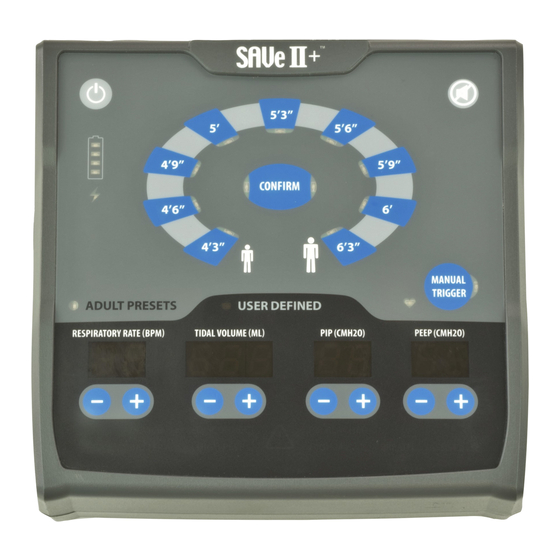Summary of Contents for AutoMedx SAVe II
- Page 1 Operating and Maintaining the SAVe II and SAVe II+ There are two training videos online. TD-0008, Rev. C SAVe II Setup: https://www.youtube.com/watch?v=T0Wfiw4OaGc 4/23/2021 SAVe II Alarms: https://www.youtube.com/watch?v=avN1IDeBBdo © AutoMedx, LLC...
- Page 2 • Using a Bag Valve Mask (BVM) for patient completely incapacitates a medic from performing other critical duties • Bagging in high stress environments has been linked to hyperventilation which increases intrathoracic pressure. This can speed up the rate of a bleed and has been shown to raise ICP and cause secondary brain injury in TBI patients...
- Page 3 Improves triage capabilities by permitting medic to treat other injuries, assist other patients, start fluids, administer drugs, help with the evacuation or re-engage. Removes the guesswork and operator error associated with bagging...
- Page 4 SAVe II / II+ Operation Extreme Functional Simplicity...
- Page 5 Tidal Volume is based on ARDSnet By selecting the height of the patient, the SAVe II dials in a lung protective, ARDSnet based TV of 6mL/Kg of ideal body weight. The Respiratory Rate is set to target a minute volume between 5-6.6 LPM depending on the height of the patient.
- Page 6 SAVe II/II+ Overview...
-
Page 7: Setup Instructions
Step B – Clear airway Step 1 – Insert airway or connect mask Step 2 - Connect breathing circuit to device Step 3 – Turn on SAVe II Step 4 – Connect breathing circuit to airway Step 5 – Verify chest rise. Monitor Alarms Step 6 –... - Page 8 Step 1 – Insert Airway The use of an ET tube, surgical or supraglottic airway is preferred over a mask. This will help reduce the risk of airway collapse or leakage around the seal of the mask. If this can’t be done, immediately ventilate with a mask until an airway can be inserted.
- Page 9 Tip: Practice until you can pull out and fully deploy the SAVe II with a mask in less than 20 seconds. Consider teaching Combat Lifesavers or others on your team how to head tilt or jaw thrust and hold a...
- Page 10 Step 3 – Turn on SAVe II 4. Verify Disconnect alarm and then block patient-end of breathing circuit and verify PIP Reached alarm Disconnect PIP Reached Tip: Once the alarm is resolved, the sound will cease, and the flashing alarm indicator will remain solid for 30 seconds.
- Page 11 Step 4 – Connect Breathing Circuit to Airway Connect the other end of the breathing circuit to the airway device or mask.
- Page 12 Step 5 – Verify chest rise. Monitor Alarms 1. Verify adequate chest rise 2. Use look up table on the back of the device to make any needed fine adjustments 3. Continue to monitor alarms...
- Page 13 Step 5 – Verify chest rise. Monitor Alarms To Monitor Pressure Simply hit the Confirm button during normal operation to see the peak pressure of the last breath Note: requires software version 1.0.4 or later. Standard on all SAVe II+ units.
- Page 14 Step 6 – If desired, connect low pressure O2 via reservoir connector 1. Remove port cap (Port cap provides extra protection to the filter. It should remain in place unless the reservoir tube or the attenuator are in use) 2. Do not remove filter (Do not run the device without a filter(s) in place as sand or dirt may get into compressor)
- Page 15 Step 6 – If desired, connect low pressure O2 via reservoir connector The amount of Supplement O required to achieve a desired FIO is determined by the minute volume being delivered to the patient. For instance, at 5’9” the default setting is to deliver 420 mL at a rate of 15 BPM. That is a minute volume of 6.3 LPM.
-
Page 16: Troubleshooting
Troubleshooting... -
Page 17: Alarm Overview
Alarm Overview Silences alarm for 2 minutes Piezo (sound) Device Disconnect PIP Reached Battery High PEEP High MV Breath Assist Alarm Dashboard (visual) - Page 18 Alarm Troubleshooting Guide Located on back of the device. More details on alarm causes and resolution are available in the Operator’s Manual.
- Page 19 Alarms Alarm Potential Cause Solution Disconnect Inadequately connected circuit Verify Patient Circuit tubing connections to SAVe II tubing control unit and airway Verify airway is tightly sealed to patient. Adjust seal Inadequate seal between patient pressure if necessary. and airway...
- Page 20 Alarms Alarm Potential Cause Solution Battery Low battery Connect device to external power if available At 15% last battery LED flashes and low priority alarm sounds for 30 seconds - At 10% last battery LED flashes and med priority alarm sounds for 30 seconds - At 5%, BATTERY indicator flashes and high priority alarm sounds - At 2% stops delivering breaths and...
- Page 21 • For storage longer than 1 month store the SAVe II/SAVe II+ at 50%-75% charged (2 or 3 battery LEDs lit) and as close to 20C as possible • A powered off SAVe II charges at the rate of 25% per hour, the SAVe II+ charges at about 60% / hour.
-
Page 22: Training Videos
Training Videos • There are two training videos online. • SAVe II Setup: https://www.youtube.com/watch?v=T0Wfiw4OaGc • SAVe II Alarms: https://www.youtube.com/watch?v=avN1IDeBBdo...





Need help?
Do you have a question about the SAVe II and is the answer not in the manual?
Questions and answers